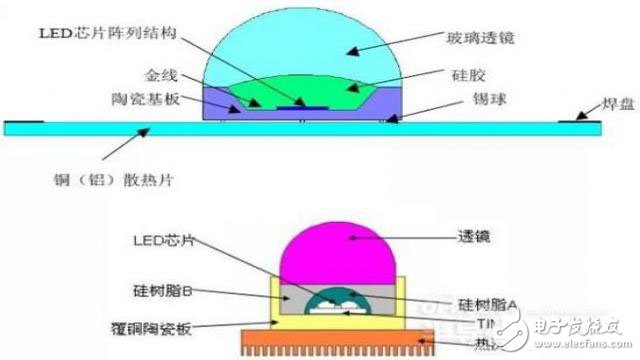At present, a single UV-LED chip is not like a white light chip, and its power is very limited. Therefore, in order to obtain high power and stable and reliable operation of a high-power UV-LED device, and to make the package structure simple and compact, it is necessary to propose a UV-LED. Array design. That is to say, a plurality of UV-LED chips are integrated in one small module to obtain a light source with a large light intensity. With COB packaging technology, the contact layer from the chip to the external environment can be minimized, thereby reducing thermal resistance and reducing material mismatch. Combined with an external chiller, the high-power UV-LED chip can maintain high-intensity illumination for a long time at a lower temperature, ensuring the reliability and stability of the UV-LED source.
Since the illuminating of the chip is emitted from all directions of the chip to the outside, when the UV-LED point source structure is designed, the UV-LED light-emitting efficiency is mainly affected by: 1) a reflective cup structure for light reflection; 2) The transmittance and refractive index of light passing through the lens; 3) the quality of the packaging process; 4) the UV aging resistance of the packaging material. These parameters will directly affect the light-emitting efficiency of the UV-LED. If the reflective cup is not designed in the package structure of the UV-LED, a large part of the light will be lost and converted into heat, which indirectly increases the difficulty of thermal management.
Currently UV-LEDs are mainly available in epoxy and silicone/glass lens packages. The former is mainly used in near-ultraviolet LED packages larger than 400 nm, and the latter is mainly used in LED packages with wavelengths less than 400 nm. Since the refractive indices of GaN and sapphire are 2.4 and 1.76, respectively, and the refractive index of the gas is 1, a large refractive index difference causes the total reflection to restrict the light from escaping, and the light-emitting efficiency of the device after packaging is low. Therefore, in the design of the lens, it is necessary to comprehensively consider the light transmittance, heat resistance and ultraviolet aging resistance of the device in the ultraviolet band.

According to the principle of light extraction, both of these structures use silica gel and glass lenses with high refractive index, which completely eliminates the total reflection effect of light and greatly improves the light extraction efficiency. These two structures are very similar. The LED chips are directly bonded to the ceramic substrate. The ceramic substrate is soldered to the copper-aluminum heat sink or the heat sink by solder balls. The thermal resistance of the entire package structure is small, and the refractive index of the outer package is small. The 1.5 silica gel and glass lens, the reflector uses the reflective cavity of the ceramic substrate. The only difference is that the latter adds a layer of encapsulated silica gel B to form a three-layer structure with decreasing refractive index, which reduces the total reflection of light loss.
In the whole package structure, the resin layer is thinner, which can reduce the absorption loss of ultraviolet light by the silicone resin as much as possible, and the three-layer structure with decreasing refractive index layer is beneficial to reduce the Fresnel loss of light during propagation. . In some cases, if it is necessary to increase the light transmittance more, an optical antireflection film can be coated on each side of the optical system.
In the above package structure, the design of the reflective cavity is also particularly important. In order to achieve the best light intensity, the reflection angle of the reflective cavity should be 55° for the best reflection angle, or the cavity angle is 70°. If the reflection angle is too large or too small, the luminous intensity will decrease.
In addition, according to the optical light-emitting principle, in order to effectively reduce the total reflection phenomenon, the principle of selecting glue is generally from the inside to the outside, and the refractive index of the glue is from high to low (the refractive index of the outer layer glue can be less than or equal to the inner layer glue refraction). Rate, but never higher than the refractive index of the inner layer of glue).
Dash dam can be divided into screen driving recorders and non-screen driving recorders, dual-lens driving recorders, smart driving recorders, etc.car camera,dash cam,Driving recorder,dash camera,hikvision dash cam,dashcam hikvision
Hangzhou Hikauto Technology Co.,Ltd , https://www.hikmotorstore.com
